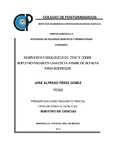Respuesta fisiológica de zinc y cobre suplementados en una dieta a base de alfalfa para borregos
Abstract
El objetivo de este estudio fue evaluar diferentes niveles de zinc y un nivel óptimo de cobre en una dieta basada en alfalfa henificada evaluada en borregos machos, con cruza de Rambouillet-criollo. Se utilizó un diseño en cuadro latino replicado, con tres periodos de evaluación y tres tratamientos (T) que fueron los siguientes: T1: 3 ppm de Cu y 0 ppm de Zn, T2: 3 ppm de Cu y 20 ppm de Zn y T3: 3 ppm de Cu y 40 ppm de Zn. Se evaluó la digestibilidad ruminal, el flujo duodenal, la digestibilidad total de la MS, MO, FDN y la utilización de compuestos nitrogenados. Asimismo, midió la absorción de zinc y cobre, el pH, N-amoniacal, la concentración de AGV (acético, propiónico butírico y la relación acético-propiónico) en liquido ruminal, No se observaron diferencias (P>0.05) atribuidas a un comportamiento similar entre tratamientos y donde el nivel único de Cu y los niveles de Zn en la dieta no afectaron el metabolismo ruminal, ni la absorción de los mismos minerales dentro del animal. La digestibilidad de la MS, MO, FDN, N, N microbiano, N amoniacal, eficiencia de N y Zn no presentó diferencias (P>0.05), solamente hubo un efecto cuadrático en la excresión de la MO. Esto se debe a que en concentraciones adecuadas de Cu y Zn en el rumen no interfieren en las actividades microbianas. Se registraron diferencias (P<0.05) de tipo lineal en el contenido de Zn en líquido ruminal atribuidas a la adición del mismo elemento; sin embargo, no se presentaron diferencias (P>0.05) en la absorción y el flujo a duodeno de las fracciones evaluadas. Un efecto lineal en Cu (P<0.05) fue observado en el mineral excretado y en la absorción total, el cual se atribuye al efecto en el incremento de Zn que provocó menor absorción del cobre por su efecto antagónico. La inclusión de cobre y zinc a las concentraciones evaluadas no afecto en la digestibilidad de nutrientes en general, ni la absorción total de los minerales evaluados. _______________ PHYSIOLOGICAL RESPONSE TO ZINC AND COPPER SUPPLEMENTED IN AN ALFALFA BASED DIET FOR RAMS. ABSTRACT: The objective of the present study was to evaluate different levels of zinc and an optimum level of copper in a hay alfalfa based diet in Rambouillet-creole male sheep. A replicate Latin square design was used with three periods of evaluation and three treatments (T), which were as follows: T1: 3 ppm Cu and 0 ppm Zn; T2: 3 ppm Cu and 20 ppm Zn; and T3: 3 ppm Cu and 40 ppm Zn. Ruminal digestibility, duodenal flow, total digestibility of DM, OM, NDF, and use of nitrogen compounds were evaluated. Likewise, zinc and copper absorption, pH, ammonia-N, VFA (acetic, propionic, butyric, and the acetic-butyric ratio) in the ruminal liquid were measured. No differences (P>0.05) were observed, attributed to a similar behavior between treatments, where the only Cu level and the three Zn levels in the diet did not affect ruminal metabolism or the absorption of said minerals in the animal. The digestibility of DM, OM, NDF, N, microbial N, ammonia N, N efficiency, and Zn showed no differences (P>0.05), there was only increased fecal OM. This is because adequate concentrations of Cu and Zn in the rumen have no interference on microbial activity. There were lineal differences (P<0.05) in Zn content in the ruminal liquid attributed to its addition in the diet; however, there were no differences (P>0.05) in absorption and duodenal flow of the evaluated diet fractions. A lineal effect in Cu (P<0.05) was observed in the excreted mineral and in total absorption. This is attributed to the effect of adding Zn, which caused a lower absorption of copper given its antagonistic effect. Including copper and zinc in the evaluated concentrations did not affect nutrient digestibility, in general, nor total absorption of the evaluated minerals.
Collections
- Tesis MC, MT, MP y DC [403]

